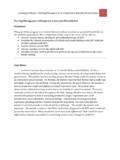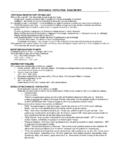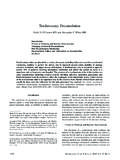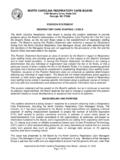Transcription of Respiratory toxicity of cedar and pine wood - In honor of ...
1 Respiratory toxicity of cedar and pine wood: A review of the biomedical literature from 1986 through 1995. Written by Jeff Johnston, doctoral candidate in epidemiology, University of North Carolina at Chapel Hill. Many pet owners, breeders and pet retailers favor wood chips as pet bedding for a variety of reasons. Most wood chips are inexpensive and depending on the wood used, wood chips can provide natural insecticidal, bactericidal or bacteriostatic properties. Such bedding can often kill or inhibit the spread of fleas, mites or other pests, and the resins and other aromatic chemicals emitted by the chips help to control pet odors.
2 With all of these advantages, pet stores often sell prepackaged starter kits for housing small pets complete with a supply of wood chips for bedding. Many people have used cedar and pine chips as bedding for these reasons. Wood from western red cedar (Thuja plicata) has one of the most potent insecticidal compounds, which accounts for its popularity to repel or kill clothes' moths. Although wood chips may provide a natural means of insect and odor control, "natural" does not always mean safe. These same chemicals can also damage the Respiratory tract, causing chronic Respiratory disease, and asthma, and some studies have found an association between exposure to some wood dusts and oral cancers.
3 The scientific literature on this topic is extremely clear, and unlike many studies of toxins, most of the scientific evidence regarding wood dust exposure has been conducted in humans rather than in laboratory animals since so many people work in the production of wood products. The summary of the biomedical literature that follows primarily describes the effect of chronic cedar - and pine-wood exposure on humans. Keep in mind that the effect on small mammals is likely to be even more pronounced, especially if they are in close, continual contact with wood chips.
4 Humans also have a relatively poor sense of smell compared with other mammals. Thus, a nasal or Respiratory irritant is much more likely to harm small mammals, which rely on smell for locating food and identifying and interacting with other animals. The primary irritant in cedar is plicatic acid and western red cedar contains the highest concentrations although eastern white cedar (Thuja occidentalis) and Japanese cedar (Cryptomeria japonica) also contain it. Exposure to plicatic acid can cause or exacerbate asthma, rhinitis or conjunctivitis in humans and in animals, and the damage can be progressive.
5 Asthmatics who are continuously exposed to cedar , such as in a lumber mill, experience deterioration in their asthma over time. In pine (family Pinaceae), the primary irritant identified is abietic acid, sometimes called sylvic acid. Pine products also include pine resin, also known as rosin or colophony, which is known to pool players and mountain climbers. Pine resin is also used in adhesives, paints and varnishes, inks and in sizing for paper, paperboard and fabrics (Sadhra 1994). Abietic acid itself elicits relatively weak allergic responses, however, a number of compounds formed by air oxidation of abietic acid are potent contact allergens (Hausen 1989, Karlberg 1988).
6 Plicatic acid has been shown to cause an array of pathological changes consistent with inflammatory and allergic reactions. However, no one knows the mechanism by which plicatic acid induces these changes, which include increased concentrations of eosinophils, immunoglobulin E (IgE), T-cells, histamine and leukotrienes--substances known to increase inflammation in conditions such as multiple organ failure following surgery and acute Respiratory distress syndrome (Frew 1995, Chan-Yeung 1994, Salari 1994). The overall increase in IgE concentrations found in humans with red- cedar asthma (Frew 1995, Paggiaro 1987) indicates an overall sensitization of the immune system to a foreign substance.
7 Similar increases in IgE levels also accompany allergic reactions and parasitic infections. Allergists and immunologists refer to this immediate immune response as a type-I hypersensitivity reaction. Humans can also exhibit a delayed reaction to red cedar or plicatic acid exposure--also known as a type-IV hypersensitivity reaction, which is the type of response seen in tuberculin skin tests in humans. Following exposure to red cedar or plicatic acid, a person with occupational asthma may have either an immediate, or a delayed reaction, or both (Malo 1989).
8 Long-term exposure to red cedar or pine in humans can lead to a decrease in forced expiratory volume, or FEV, a measure of lung capacity and ability to breathe freely (Shamssain 1992, Cote 1990, Malo 1989). Plicatic and abietic acids can both cause destruction and desquamation, or sloughing, of alveolar, tracheal and bronchial epithelial cells (Ayars 1989). Among the known causes of occupational asthma, red cedar has a significant impact compared with most other occupational exposures. One study compared four groups of employees who worked at jobs that exposed them to Respiratory irritants: cedar sawmill, paper pulpmill, grain elevator and aluminum smelter workers.
9 The sawmill workers had the highest overall prevalence of asthma compared with a control group of persons without any occupational Respiratory exposure (Siracusa 1995). Studies of workers exposed to pine dust also show that such work is associated with significantly more Respiratory symptoms and a greater risk of airflow obstruction (Shamssain 1992), and the results of a German study indicate that workers exposed to pine dust had more than a three-fold increased risk of glottal cancer (relative risk = , 95% confidence interval: ) (Maier 1992).
10 In humans, occupational exposure to cedar leads to asthma in 50% of more of wood, paper and pulp mill workers (Malo 1994, Rosenberg 1989). One might expect that longer exposure to cedar or pine dust would result in worse or more persistent Respiratory symptoms, but that is not clear from various studies. Some researchers report just that among timber workers with occupational asthma who remain exposed to wood dust (Rosenberg 1989). In contrast, a large study of British Columbia cedar sawmill workers found that physician diagnoses of asthma or Respiratory symptoms were not associated with work duration or the amount of dust to which the workers were exposed (Vedal 1986, vol.)







